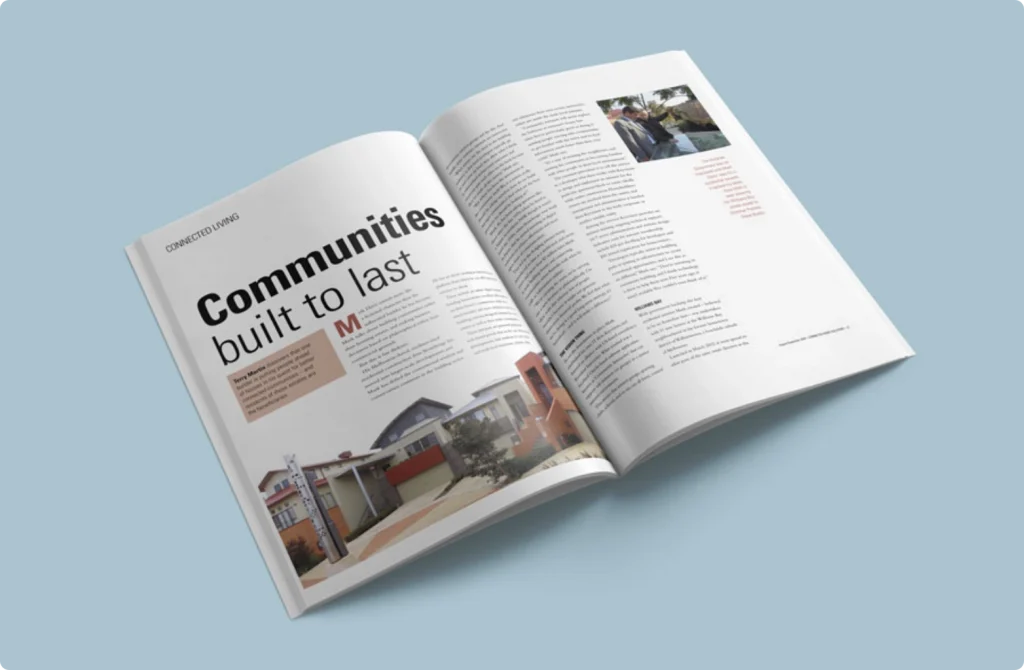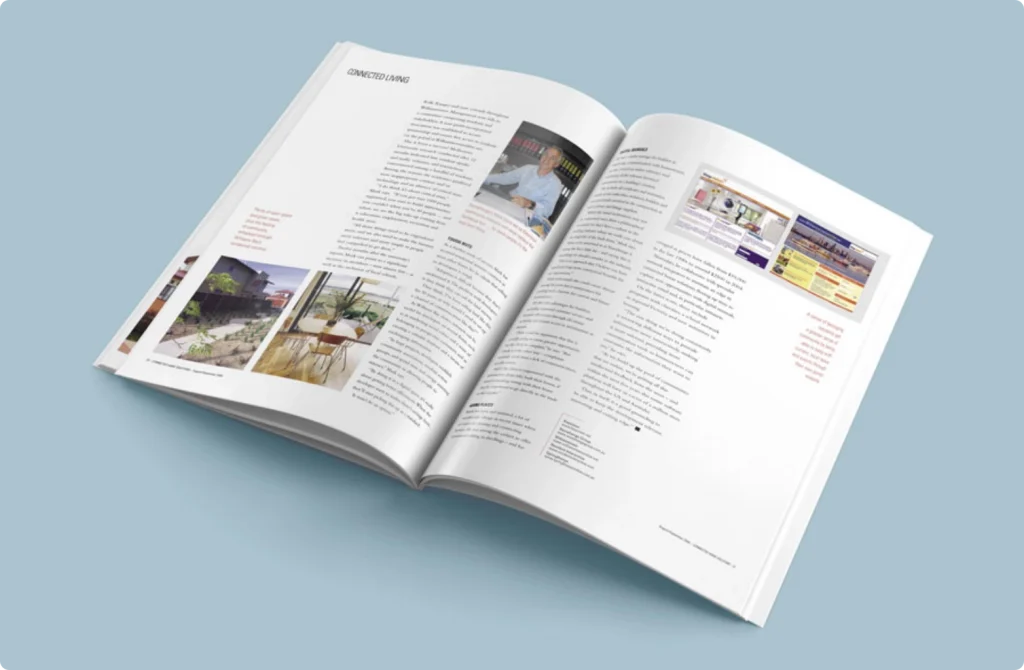


The Victorian Government was so impressed with Mark Davis’ idea for a residential intranet, it backed his ideas.
Here Mark is seen showing his Williams Bay estate model to Victorian Premier, Steve Bracks.
Terry Martin discovers that one builder is putting people ahead of houses in his quest for better connected communities – and residents of these estates are the beneficiaries
Mark Davis sounds more like a fictional character than the influential builder he has become. Mark talks about building communities rather than housing estates, and making business decisions based on philosophical rather than commercial grounds.
But this is fair dinkum.
His Melbourne-based, medium-sized residential construction firm Stonehenge has moved into larger-scale developments, and Mark has defied the conventional wisdom and conservatism common in the building sector.
He has set about creating an internet-based platform from which he can offer innovative services to clients.
These include an online ‘digital manual’ handing homeowners excellent information on their house’s construction, while on a much broader and more ambitious scale he is building custom-designed intranets for new estates as well as their wider communities.
These intranets are password-protected web-based portals that, in the case of housing developments, link residents to each other and with local businesses, schools, clubs, associations, interest groups and the like. And
unlike static websites, intranets are interactive.
“What annoys me the most in the building industry is that land developers typically go in and carve up land, they allow what I think is substandard architectural outcomes and everyone pats each other on the back because they’ve made all this money,” Mark says.
“But where has been the investment in the community itself? We, as a nation, really should be asking ourselves: how do we build stronger communities? And what are the best practices we should be looking at?”
Mark, 46, has been asking questions like these since the late 1970s when he lived as a hippie in northern NSW, though it wasn’t until the 1990s, when Stonehenge won work in Japan, that he started investing in digital solutions to achieve efficiencies and more open lines of communication.
This led to the fledgling internet being introduced to him as a useful tool, and, seven years and more than $2 million later, Mark is now building houses and connecting communities across Australia with what he calls as ‘information utilities’.
“We’re creating the route, we’re carving out a new frontier, so philosophically I’m okay with that whereas lots of people wouldn’t because it might not generate short-term financial profits. We feel that what we’re doing is a good long-term strategy, it’s beneficial – and it will make a difference.”
THE VISION THING
To set the foundations in place, Mark established his own IT firm, Keyvision, and formed an alliance with US-based consultancy Resident Interactive. What resulted was a localised Oracle-based software application
known as ‘Community Interactive’ that can support sub-intranets (or groups) in a master intranet environment.
This means that interest groups, sporting clubs, schools, and so on, can all form, control and administer their own secure, interactive online site inside the main local intranet.
“Community intranets will never replace the barbecue at someone’s house but
what they’re particularly good at doing is assisting people moving into communities to get familiar with the town and to find information much faster than they ever could,” Mark says.
“It’s a way of assisting the neighbours, and assisting the community, in becoming familiar with other people in their local environment.”
The common procedure is to sell the service to a developer who then works with Keyvision to design and implement an intranet for the particular apartment block or estate, ideally while under construction. Homebuilders/
owners are involved from the outset, and management and administration is handed from Keyvision to the body corporate or another suitable entity.
Among the services Keyvision provides are intranet training, ongoing technical support, 24/7 server administration and website design.
Indicative costs for intranet membership include $35 per dwelling for developers and $30 annual registration for homeowners.
“Developers typically invest in building parks or putting in infrastructure to create recreational opportunities, and I see this as no different,” Mark says. “They’re investing in community-building, and I think technology is there to help them now. Five years ago, it wasn’t available. You couldn’t even think of it.”
WILLIAMS BAY
With government backing, the first residential intranet Mark created – believed to be an Australian first – was undertaken with 51 new houses at the Williams Bay neighbourhood in his former hometown district of Williamstown, a beachside suburb of Melbourne.
Launched in March 2002, it soon spread to other parts of the same estate (known as Rifle Range) and now extends throughout Williamstown. Management now falls to a committee comprising residents and stakeholders. A non-profit incorporated association was established to secure sponsorship and ensure free access to residents via the portal at Williamstownonline.net.
The The Victorian Government was so impressed with Mark Davis’ idea for a residential intranet, it backed his ideas.
Here Mark is seen showing his Williams Bay estate model to Victorian Premier, Steve Bracks.
Has it been a success? Melbourne University research conducted after 12 months indicated low resident uptake and traffic volumes, and interactions concentrated among a handful of residents.
Among the reasons the academics proffered were inappropriate content and/or
technology and an absence of critical mass.
“I do think it’s about critical mass,” Mark says. “If you get over 1000 people registered, you start to build opportunities you couldn’t when you’ve 50 people … and where we see the big take-up coming from is education, employment, recreation and health areas.
“All those things need to be engendered more, and we also need to make the intranet more relevant and more simple so people feel compelled to go there.”

Twelve months after the university’s report, Mark can point to a significant
increase in members – now almost 500 – as well as the inclusion of local schools.
TOUGH NUTS
As a further mark of success, Mark has secured residential intranet contracts in most other States. Yet he admits that selling to developers is tough.
“Adoption is difficult because they don’t understand it. The problem with developers is they think they can sell the land anyway.
They think, ‘I’ve been selling land like this for 50 years, so why would I need to set up a channel of communication like this?’”
As Williams Bay shows, intranets can be useful for developers on several fronts, such as in marketing social values and a sense of belonging to prospective customers, and in creating a valuable database and a means of
exchanging information.
“In large projects, developers establish community associations, resident action groups, and spend time and energy assisting the community in allowing people to interact,” Mark says.
“By doing it in a digital space, it’s really about getting better efficiencies. When the developer starts to realise there’s savings here, they’ll start picking this up as a standard.It won’t be an option.”
DIGITAL MANUALS
He has a similar message for builders in improving communication with homeowners, and has created an online reference tool containing all the relevant historical information on a building’s creation.
This includes all certificates and warranties, details on the authorities, architects, builders and associated trades involved in the construction as
well as fixture and fittings suppliers.
“Whilst the initial motivations may not be commercial ones, from a philosophical viewpoint we don’t have a culture in the building industry where we really care about the longevity of the built form,” Mark says.
“What we’re interested in at Stonehenge is raising the bar a little bit – and saying this is something we should consider in the industry.
“This is an approach that I believe can have significant long-term commercial benefits for any organisation.”
Mark understands this could create dissent among his peers but is unrepentant for pushing such a barrow for current and future homeowners
He also cites advantages for builders, including improved customer service and business efficiencies through electronic archiving and instant access to information in disputes.
“There could be arguments that this is actually going to create greater opportunity for the client to complain,” he says. “But I look at it the other way – complaints normally result from a lack of communication, not the reverse.
And if the client is empowered with the information about who built their house, if there’s something wrong with their home they’re empowered to go directly to the trade or the supplier.”
GOING PLACES
Mark has seen, and initiated, a lot of worthwhile change in recent times when it comes to creating and connecting homes. He was among the earliest to offer structured cabling in dwellings – and has cringed as prices have fallen from $10,000 in the late 1990s to around $2500 in 2004.
Nowadays, he collaborates with specialist network integrators to maintain an edge in connected home solutions, freeing up time to explore new opportunities with digital manuals, interactive email and, in particular, intranets.
On the latter score, these include programs with charities, a school network
in regional Victoria and new initiatives in housing.
“The one thing we’re doing consistently is reviewing different ways to provide information more interactively, making it more relevant, providing more customisation tools so homeowners can customise the information they want to see,” he says.
“As we build up the pool of communities that are online, we’re getting all this intellectual feedback from the users – and within the next five years this entire software platform will have in excess of a million users
throughout the US and Australia.
That, in itself, is a good grounding to be able to keep the development relevant, interesting and cutting edge.”